Répudre aqueduct,
the 1st one to be built in France, and the oldest in Europe today
After Argens-Minervois and the villages of Roubia and Paraza, the Canal du Midi winds around a hairpin bend to pass over Répudre aqueduct. This engineering structure is the oldest canal aqueduct in France and the 2nd oldest in the world.
Répudre aqueduct, the first navigable aqueduct in France
Répudre aqueduct straddles the towns of Paraza and Ventenac-en-Minervois, and was the very first navigable aqueduct in France, and the second in the world!
The water levels of the Répudre river, a relatively modest tributary of the Aude river, can rise very quickly and create significant floods. The creator of the canal, Pierre-Paul Riquet, decided to pass the canal over this river using a canal aqueduct, and entrusted architect Emmanuel de Lestang with the project. The architecture was similar to any other standard aqueduct, but it would be adapted to navigation in that the width and depth of the basin needed to be big enough for a boat. The aqueduct also needed to be big enough to straddle the river, and robust enough to resist the violent flash floods. With 90 m in length and its unique arch, Répudre aqueduct had a much more monumental appearance than any other aqueducts built before. It looked more like a bridge than an aqueduct and was initially called Répudre bridge, before this was changed to Répudre canal aqueduct.
The plans for this engineering structure were inspired by an Italian model designed in the 15th century for the Martesana canal to pass over the Molgora river. Pierre-Paul Riquet had a contract drawn up on 8 September 1677 entrusting Emmanuel de l’Estang with the construction, but he encountered many difficulties during the building work. In May 1680, the aqueduct still wasn't completed and Riquet and his entrepreneur had to settle a significant financial dispute.
As a result, in July 1680, Riquet put Emmanuel de l’Estang in prison. He stayed there for 10 months, until Riquet's eldest son (Riquet having passed away in October 1680) posted bail for his release, 13 days before the inauguration of the canal.
On 23 May 1681, the very first barges sailed across the canal aqueduct. Someone who witnessed this event said "It's extraordinary to see these big vessels sailing over the bridge". Contemporaries and travellers along the Canal du Midi were highly impressed with this technological achievement.
Pierre-Paul Riquet's heirs had a commemorative plaque installed on the south side of the aqueduct in 1839. The plaque specifies that this was the first aqueduct built on the Canal du Midi, and it was thanks to Pierre-Paul Riquet. The date engraved into stone, 1676, marks the beginning of the structure's design.
A reference for other canal aqueducts designed by Vauban
Bearing in mind the high cost of this construction, Riquet only used the same plans three times and the other two were much smaller aqueducts (Marseillette and Jouarres). Rivers crossed the canal over embankments.
Upon request from Louis XIV, Vauban carried out an inspection of the canal and recommended construction work to improve Riquet's creation, and in particular to resolve the siltation issues caused by the rivers flowing into the canal.
Répudre aqueduct was a pioneering structure and Vauban used it as a reference in his recommendations to build 60 other aqueducts. 49 of them were actually built, including Orbiel and Cesse, the two biggest aqueducts on the Canal du Midi, in the 17th and 18th centuries.
Places to see
The beautiful nearby villages of Paraza and Ventenac-en-Minervois are great places to stop for something to eat or for a stroll, to discover the artists of Paraza and enjoy a wine tasting at the Château de Ventenac.

Ventenac - VNF, Sylvain Cambon












